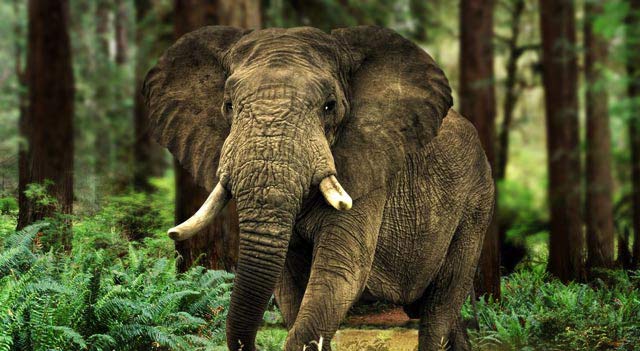Facts About Baby Elephants Similar Animals to Elephants
Related Articles
What Are Elephant
Types Of Elephants
Where Elephants Are Found
Deviation Betwixt Asian And African Elephants
Life Span Of An Elephants
Elephant Tusk Facts: Elephant Teeth Facts
Average Size Of An Elephant
What Elephants Eat And Drink
In that location are two major types of elephants in the world, namely, African and Asian. Both of these are facing the danger of extinction equally the ivory hunters are posing serious threat to the very being of the largest mammals on earth.
Asian Elephants
These are besides known equally Indian elephants and are now considered to exist endangered as well-nigh half of their population has declined in the by half dozen or seven decades. Presently, less than 50,000 mature individuals have been reported living in the wild habitat and well-nigh 15,000 in captivity in the zoos. Approximately fifty% of these live in India alone, while the remaining population is dispersed across various other nations of Asia. Based on the slight morphological differences, they are farther divided into 3 types or subspecies, namely, Sri Lankan, Indian and Sumatran.
African Elephants
They alive in Southern, Eastern and Western parts of the African continent and are dissimilar from their Asian counterparts. Nonetheless, they are farther recognizable into two species, namely, African Forest Elephants and African Bush Elephants both of which are classified in the genus Loxodonta. In the previous some decades, their population has been declining drastically as in the decade of 1980s, out of the population of 1.three million about 700,000 individuals were put to death by the poachers. Even so, they take not been included in the listing of endangered animals past the IUCN (International Union for Conservation of Nature).
Threats to Elephants
Both Asian as well as African elephants are facing different types of threats to their protection, survival and the propagation of generation. The major kinds of threats are being posed by the anti-nature activities of humans, such as deforestation, and poaching.
Threats to Indian/Asian Elephants
Owing to a number of contributing factors, the Indian species of elephants are being rapidly dragged towards extinction. The ascendant causes include deforestation, poaching and human-elephant conflict. People are clearing forests and destroying their habitat for their one-sided gains, such as agronomical utilization and the institution of human settlements.
Expanding population ever requires more agricultural state to meet the food needs of the human beings. For this end, local governments are wiping out the forests so that the land may exist utilized for harvesting more than and more than food crops. This is a crusade of destruction of the natural habitats of elephants and other endangered species. Notwithstanding, the poaching of Indian elephants is not as common equally that of African species.
Threats to African Elephants
The primary and well-nigh devastating threat to both African bush-league & African woods elephants is that of poaching which is washed specially for the sake of ivory. Ivory is used for making different articles of immense beauty and value; therefore, the hunters kill them to obtain this precious role of their torso. Specially attributable to global warming, the quickly changing temper is creating some problems for the survival of these already dwindling organisms.
Endangered Elephants Facts
- In the past there were many species of elephants, which lived over about of the world except Australia. Some were much bigger than the elephants of today, merely they are now extinct. As a result of hunting for ivory, poaching and exploitation of the elephants' natural dwelling house, there are far fewer elephants today than they were just 20 years dorsum. Many people are of the point of view that it is non possible for such large and enervating animals to survive and flourish in a world of expanding man populations.
- In the biological organisation of naming organisms, African and Asian Elephants are termed as Loxodonta africana and Elephas maximus, respectively, where the former role of their proper name refers to their item genera and the latter denotes species.
- Three subspecies of Asian elephants and two of African elephants have been recognized that have unlike geographical distribution and distinct concrete characteristics.
- Practice y'all know the name of the largest terrestrial animals that are found in the globe of today? They are not other than the male African elephants that measure equally heavy as 7,000 kg in weight and reach up to the height of 4 meters or xiii anxiety!
- In the wild, the lifespan of African elephants is shorter than that of their Asian counterparts as the former live for just 60 years, while the latter achieve the maximum historic period of 75.
- Though the encephalon size of whales is larger than that of any other beast on the planet world, concerning the encephalon-to-body ratio, elephant take the atomic number 82.
- It is surprising to notation that when a fetus, in the womb of a female elephant, grows upwardly to the mass of 5 kg, its encephalon size measures larger than that of whatsoever other terrestrial fauna. What will exist its encephalon size in comparison to that of humans when information technology is born with the torso mass of 100 kg?
- In the life history of humans, the teeth are replaced only once, while these animals have been found to replace their teeth for as many every bit half dozen times!
- Elephants exhibit a high degree of intelligence and are considered as one of the most intelligent species in the globe, as their highly convoluted neocortex is shared by dolphins, apes and humans.
- They show a number of startling behaviors that are quite similar to those of humans, such every bit a sense of humour, play, self-awareness, memory, fine art, altruism, grief, joy and the use of tools.
Source: https://www.liveanimalslist.com/mammals/elephants-endangered-species-facts.php

0 Response to "Facts About Baby Elephants Similar Animals to Elephants"
Post a Comment